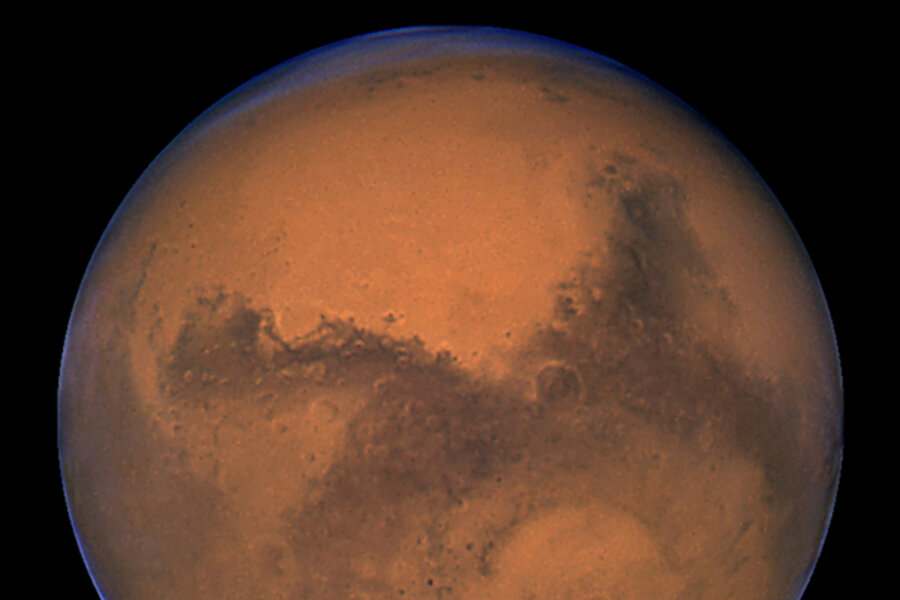Cosmic rendezvous: Mars and Regulus to form striking pair in June
Loading...
The red planet Mars and a bright star are teaming up in June to offer a colorful show in the night sky for amateur astronomers.
For the first few weeks of June, Mars and the star Regulus will appear to move closer together, making them a good target for skywatchers graced with clear weather and good viewing positions.
Mars will appear halfway up in the western sky after dusk by forming a striking "double star" with the first-magnitude star Regulus from now through the middle of June. The red planet shines within 5 degrees of Regulus from May 28 to June 15. [How to measure sky distances.]
For comparison, a clenched fist held up at arm's length would cover about 10 degrees of arc in the sky. The brightness of an object in the night sky is measured as its magnitude. In the magnitude scale, a magnitude 1 star like Regulus would be 100 times brighter than a magnitude 5 star.
Eye-catching Double Star
From June 2 to 10, Mars and Regulus are within just 2.5 degrees of each other. The cosmic rendezvous is known as a conjunction — the name for when two objects in the night sky appear to be very close to each other.
The conjunction and appulse — which means the point of least separation — will occur on June 6, with Mars scraping within 0.8 degrees of Regulus. On that evening, Mars will shine just above to the right of the star.
On the following evening the planet and star will be not quite as close, but Mars will have shifted to a position about 0.9 degrees directly above Regulus. Mars will shine at magnitude 1.2, so it should look ever so slightly brighter than Regulus at magnitude 1.34.
With the naked eye, and especially binoculars, you can see how greatly the contrasting colors of golden-orange Mars and slightly blue-tinged Regulus are accentuated by the two objects appearing so close to each other.
In a small telescope, Mars looks little more like a star itself. With an apparent diameter of less than 6 arc seconds it's hardly bigger than Uranus.
Mars on the move
Currently, Mars is continuing to recede away from Earth it orbits the sun. When it was opposite to the sun in the sky in late January, it shined at a dazzling magnitude -1.3, nearly as bright as Sirius — the brightest star in the night sky. At the time, Mars was moving rapidly to the west against the dim stars of Cancer, the Crab.
On March 10, the mutual motions around the sun of Earth and Mars had Earth moving directly away from the red planet. So it appeared to be standing still against the star background and fading in brightness. It then began its normal eastward motion and is now rapidly crossing before the stars of Leo, the Lion.
And yet, despite its fade-down, it will be interesting to watch the motion of Mars as it moves through Leo's familiar sickle and triangle star pattern. Its movement is fast enough to be noticeable from week to week, if not from day to day.
On the evenings of June 16 and 17, a lovely crescent moon will be sliding to the south of the widening Mars-Regulus duo.
During the balance of June, Mars will continue to slide east through Leo. Another easy comparison of its movement with background stars is with the triangle marking Leo's hindquarters.
The second-magnitude star Denebola marks Leo's tail. Mars will pass well south of Denebola on July 23, then will pass to the south of another planet — Saturn — on Aug. 1. Then, as the summer wanes, it will pass two degrees north of the first-magnitude star, Spica of Virgo on Sep. 4.
By then, Mars, which was so dazzling when 2010 began, will have faded to magnitude 1.5. It will appear only 1/13 as bright as it did in late January, its distance from Earth having increased to 201 million miles (322 million kilometers).
Joe Rao serves as an instructor and guest lecturer at New York's Hayden Planetarium. He writes about astronomy for The New York Times and other publications, and he is also an on-camera meteorologist for News 12 Westchester, New York.





